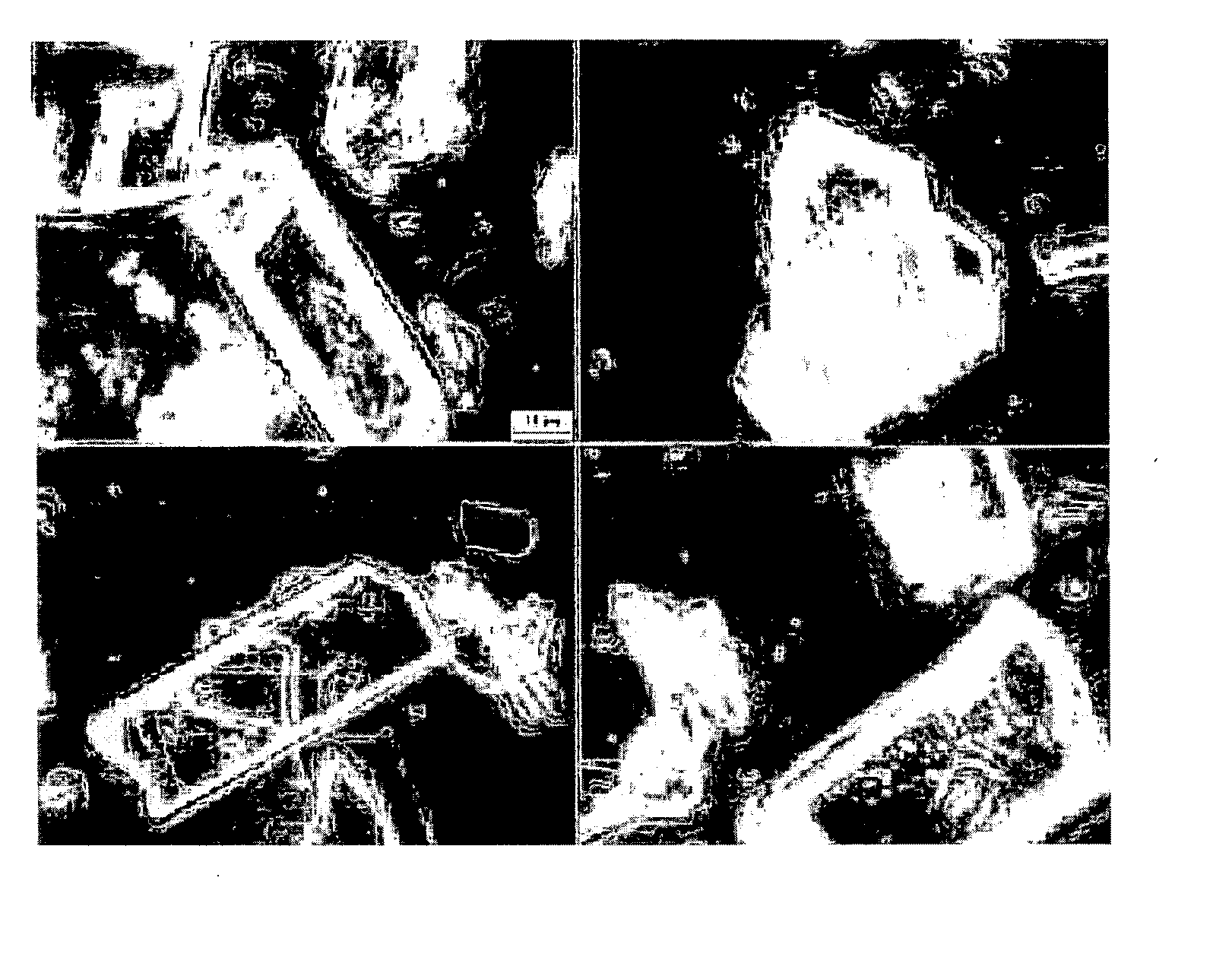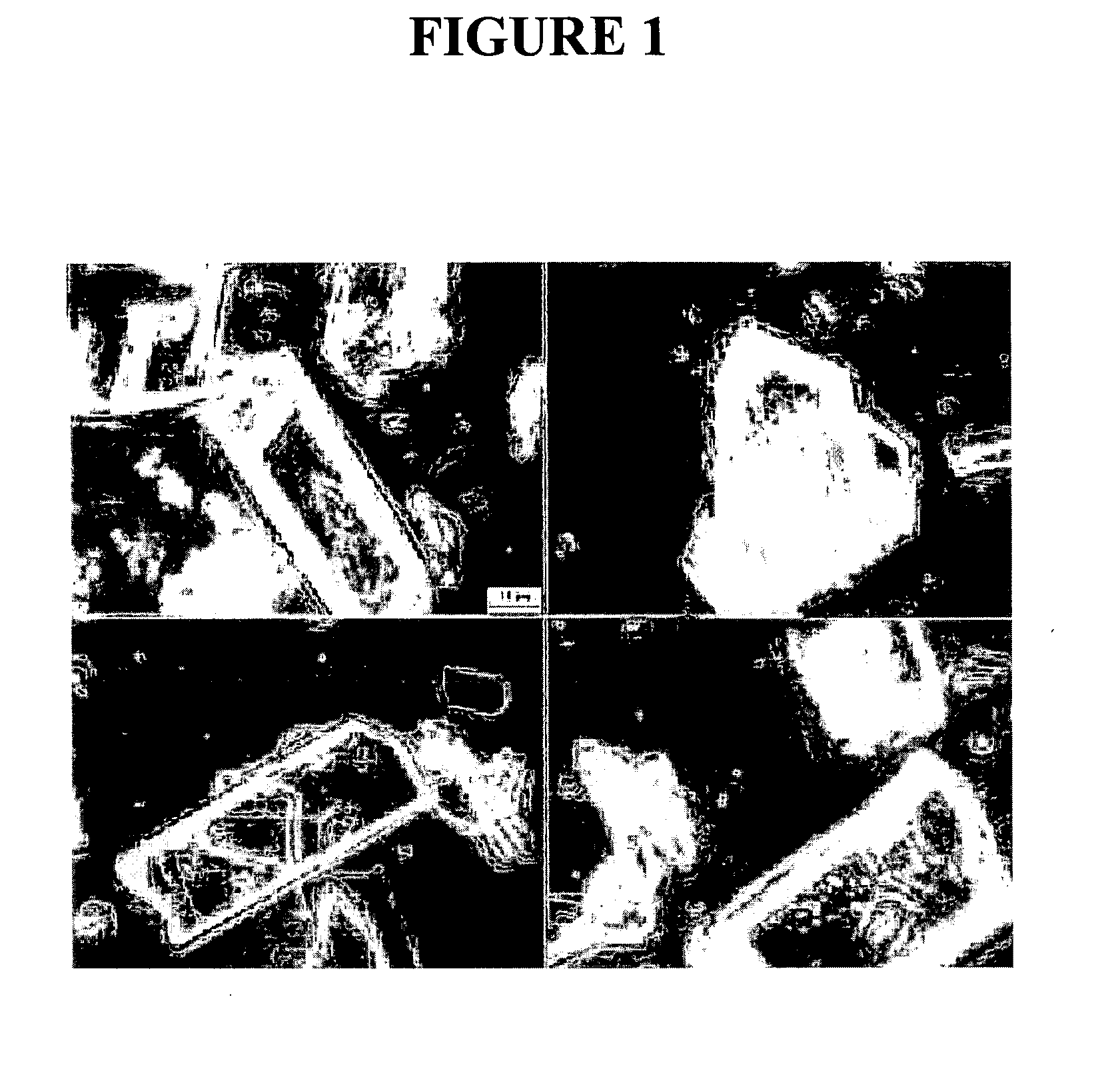Nanoparticulate tacrolimus formulations
a technology of tacrolimus and nanoparticulate, which is applied in the direction of anti-noxious agents, immunological disorders, applications, etc., can solve the problems of incomplete and variable absorption of tacrolimus from the gastrointestinal tract after oral administration, and achieve the effect of enhancing patient convenience and compliance, and rapid drug dissolution
- Summary
- Abstract
- Description
- Claims
- Application Information
AI Technical Summary
Benefits of technology
Problems solved by technology
Method used
Image
Examples
example 1
[0205] The purpose of this example was to prepare a nanoparticulate tacrolimus formulation. FIG. 1 shows a light micrograph using phase optics at 100× of unmilled tacrolimus.
[0206] An aqueous dispersion of 10% (w / w) tacrolimus (Camida LLC), combined with 2% (w / w) polyvinylpyrrolidone (PVP) K29 / 32 and 0.05% (w / w) dioctylsulfosuccinate (DOSS), was milled in a 10 ml chamber of a NanoMill® 0.01 (NanoMill Systems, King of Prussia, Pa.; see e.g., U.S. Pat. No. 6,431,478), along with 500 micron PolyMill® attrition media (Dow Chemical) (89% media load). The mixture was milled at a speed of 2500 rpms for 60 minutes.
[0207] Following milling, the particle size of the milled tacrolimus particles was measured, in deionized distilled water, using a Horiba LA 910 particle size analyzer. The initial mean milled tacrolimus particle size was 192 nm, with a D50 of 177 nm and a D90 of'278 nm. FIG. 2 shows a light micrograph using phase optics at 100× of the milled tacrolimus. In a second measurement ...
example 2
[0209] The purpose of this example was to prepare a nanoparticulate tacrolimus formulation.
[0210] An aqueous dispersion of 10% (w / w) tacrolimus (Camida LLC), combined with 2% PVP K12 and 0.15% sodium deoxycholate, was milled in a 10 ml chamber of a NanoMill® 0.01 (NanoMill Systems, King of Prussia, Pa.; see e.g., U.S. Pat. No. 6,431,478), along with 500 micron PolyMill® attrition media (Dow Chemical) (89% media load). The mixture was milled at a speed of 2500 rpms for 150 minutes.
[0211] Following milling, the particle size of the milled tacrolimus particles was measured, in deionized distilled water, using a Horiba LA 910 particle size analyzer. The mean milled tacrolimus particle size was 329 nm, with a D50 of 303 nm and a D90 of 466 nm. FIG. 4 shows a light micrograph using phase optics at 100× of the milled tacrolimus.
[0212] The results demonstrate the successful preparation of a stable nanoparticulate tacrolimus formulation, as the mean particle size obtained was 329 nm.
example 3
[0213] The purpose of this example was to prepare a nanoparticulate tacrolimus formulation.
[0214] An aqueous dispersion of 20% (w / w) tacrolimus (Camida LLC), combined with 3% (w / w) Pluronic® S630 and 0.05% (w / w) DOSS, was milled in a 10 ml chamber of a NanoMill® 0.01 (NanoMill Systems, King of Prussia, Pa.; see e.g., U.S. Pat. No. 6,431,478), along with 500 micron PolyMill® attrition media (Dow Chemical) (89% media load). The mixture was milled at a speed of 2500 rpms for 60 minutes. A light micrograph using phase optics at 10033 of the milled tacrolimus is shown in FIG. 5.
[0215] Following milling, the particle size of the milled tacrolimus particles was measured, in deionized distilled water, using a Horiba LA 910 particle size analyzer. The initial mean milled tacrolimus particle size was 171 nm, with a D50 of 163 nm and a D90 of 230nm. In a second measurement in distilled water following 1 week of refrigeration at <15° C., the mean tacrolimus particle size was 194 nm, with a D5...
PUM
| Property | Measurement | Unit |
|---|---|---|
| particle size | aaaaa | aaaaa |
| particle size | aaaaa | aaaaa |
| particle size | aaaaa | aaaaa |
Abstract
Description
Claims
Application Information
 Login to View More
Login to View More - R&D
- Intellectual Property
- Life Sciences
- Materials
- Tech Scout
- Unparalleled Data Quality
- Higher Quality Content
- 60% Fewer Hallucinations
Browse by: Latest US Patents, China's latest patents, Technical Efficacy Thesaurus, Application Domain, Technology Topic, Popular Technical Reports.
© 2025 PatSnap. All rights reserved.Legal|Privacy policy|Modern Slavery Act Transparency Statement|Sitemap|About US| Contact US: help@patsnap.com



